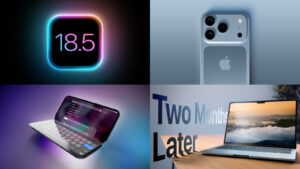FineWoven will join a long line of short-lived Apple failures

After a little more than a half-year on the market, a new report claims that Apple has stopped production of its beleaguered FineWoven products, which were introduced in September as an eco-friendly alternative to leather iPhone cases and Apple Watch bands. There may be a new round of spring colors (likely launched at the Let Loose event in May) but rumors say Apple will switch to some other synthetic material in the fall and dump FineWoven just 12 months after it launched.
FineWoven was supposed to be Apple’s big move away from leather. The accessories are made from “68 percent post-consumer recycled content” as part of Apple’s long-standing efforts to reduce carbon emissions. Still, even customers who wanted Apple to get rid of leather were less than thrilled about the new material, which Apple says “may show wear over time as the fibers get compressed with normal use.” Pictures posted around social media have shown how worn down the cases look after a short time compared to the old leather cases.
We won’t know for sure until September if Apple is truly planning to discontinue the line of accessories, but if it is, FineWoven will have some well-known company in the annals of short-lived Apple products:
Macintosh XL (3 months)
If the Macintosh precursor Lisa was troubled, the Macintosh XL, released in January 1985 at the tail end of Lisa’s run, was downright doomed. It wasn’t for the lack of specs or interest—in fact it sold quite well—but the line was overshadowed by the cheaper Macintosh. Resources and parts were scarce for the Macintosh XL and Apple ran out of stock forever just three months later.
Macintosh TV (4 months)
The original Apple TV before streaming was a thing, the Macintosh TV was supposed to be the device that combined personal computing with home entertainment. With a built-in 14-inch Sony Trinitron display and all of the necessary audio/video inputs including a coaxial cable input, the Macintosh TV combined Apple’s iconic all-in-one design with “new media capabilities that create a whole new category of computing and entertainment devices.” It didn’t catch on and Apple pulled the plug on its first TV project just four months later.
The Power Mac G4 Cube was built for success, but never got off the ground.
Power Mac G4 Cube (11 months)
The Power Mac G4 Cube made a huge splash at Macworld New York in 2000. A mini high-end tower packed inside a beautiful floating acrylic square with an ingenious handle to access the internal parts, the Power Mac G4 Cube should have been a runaway hit. Instead, the high price and various cosmetic and performance issues kept sales at bay, and less than a year later, Apple put the whole project “on ice.”
eMate (11 months)
Before the iBook there was a small translucent portable Mac called the eMate 300, which was geared toward the education market. The ultraportable laptop had a 25MHz ARM CPU, 1MB of RAM, and 2MB of flash memory for a very affordable $799. The eMate was ultimately a victim of Apple’s new direction under Steve Jobs, but that’s not the last we would see of transparent plastic cases.
iPod Hi-Fi had one job and did it well, but it was too heavy and expensive to catch on.
Roman Loyola/IDG
iPod Hi-Fi (19 months)
Back when the company’s iconic music player was at the height of its popularity, Apple tried to cash in on the dedicated speaker market with the iPod Hi-Fi, a high-end audio system made specifically for the iPod. The boombox-esque design with exposed speakers and glossy white chassis was extremely big and heavy and had one job as a somewhat precarious $349 iPod dock. It did its job well, but was a victim of a high price and bad timing, lasting less than two years—during which time another new product named the iPhone arrived. That one would last a little longer.
iPhone, Mac


